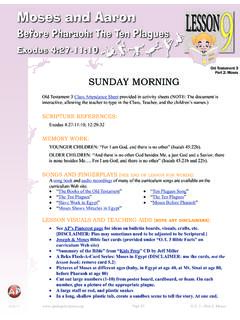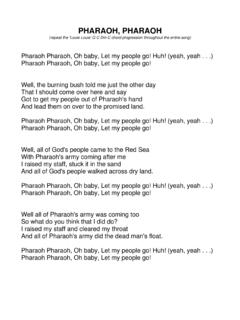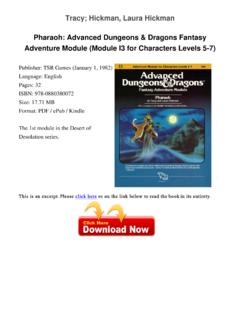Transcription of Egypt's Chronology in Synchronization with the Bible
1 Egypt's Chronology in sync with the Holy Bible by Eve Engelbrite, p1 Egypt's Chronology in Synchronization with the BibleThis Egyptian Chronology is based upon the historically accurate facts in the Holy Bible which are supported by archaeological evidence and challenge many assumptions. A major breakthrough was recognizing Joseph and Moses lived during the reigns of several pharaohs, not just one. During the 18th dynasty in which Joseph and Moses lived, the average reign was about 15 years; and Joseph lived 110 years and Moses lived 120 years. The last third of Moses' life was during the 19th dynasty. Though Rameses II had a reign of 66 years, the average reign of the other pharaohs was only seven Chronology is superior to traditional Egyptian chronologyJoseph was born in 1745 BC during the reign of Tao II. Joseph was 17 when he was sold into slavery (1728 BC), which was during the reign of Ahmose I, for the historically accurate amount of 20 pieces of Moses (1571-1451 BC) was born 250 years after the death of the Hebrew patriarch, Abraham.
2 Moses lived in egypt and wrote extensively about his conversations and interactions with the pharaoh of the Hebrews' exodus from egypt ; thus providing a primary source. The history of the Hebrews continued to be written by contemporaries for the next thousand years. These books (scrolls) were accurately copied and widely disseminated. The Dead Sea Scrolls contained 2,000 year old copies of every book of the Bible , except Esther, and the high accuracy of these copies to today's copies in original languages is truly astonishing. For example, the book of Isaiah is 95% accurate: The five percent of variation consisted primarily of obvious slips of the pen and spelling alterations. 2 Herodotus and Manetho The first historian of Egyptian history, Herodotus, lived about 484 425 BC. But most Egyptologists use the list of pharaohs created by the Egyptian priest Manetho, who wrote a 2,000 year linear history of egypt around 240 BC.
3 This was 2000 years after the birth of Menes/Mizraim, the first pharaoh after Noah's flood. Manetho's dynasties were based on geographic location, or new genealogical shift. No copies remained by 75 AD when Josephus tried to piece it back together from other writings (some particularly anti-Jewish) which quoted Manetho. No copies of Josephus' epitome of Manetho remain, but only translations made 200 years later. Even if Josephus had managed to recreate Manetho's original work, only third-hand altered copies remain upon which the foundation of conventional Egyptian history divided Manetho's dynasties into the following chronological groups:Conventional ChronologyDynastiesDynasties in Bible -sync ChronologyOld Kingdom1-6 1-3, and 7 First Intermediate Period 7-104, 5, 8, 9, 10, 12, 13, and pre-15 Middle Kingdom11-13none; FIP followed by SIPS econd Intermediate Period 14-176, 9, 10, 11, 12, 13, 14, pre-15,15, pre-16, 16, and 17 New Kingdom18-2118-21 and 21A (Theban high priests)Third Intermediate Period22-2622 and 23, followed by 24-26 combinedLate Period27-3127-311 Reznick, Rabbi Leibel, Egyptology in the Torah: Biblical Archaeology, The rabbi listed several other historically accurate facts in the Torah (Genesis Deut.)
4 During Joseph's time in , Gleason, A Survey of Old Testament Introduction Chicago: Moody 1974, p. 25 Egypt's Chronology in sync with the Holy Bible by Eve Engelbrite, p2 Turin King List on PapyrusIn the 1800's, an Italian discovered a list of kings on the back of a tax scroll along with several papyrus fragments, and it was placed in the egypt Museum in Turin, and dubbed the Turin King List (TKL). It was most likely a scribal student's homework. Regarding the tabulation of years ruled by the 12th dynasty, Ryholt noted Apparently the scribe did not realize that several of the reigns in question included a period of coregency, and that the duration of the dynasty was therefore in reality much shorter. 3 Ryholt wrote, .. the Turin King-list proceeds chronologically throughout, except that contemporary dynasties are recorded one at a time in order not to mix kings of different dynasties.
5 4 and added it is the only genuine king-list from ancient egypt . 5 The Turin King List has discrepancies and many additions to those kings found in Manetho's list. The Turin King List includes dynasties which are usually dismissed by chronologists: the pre-15th dynasty of twelve kings (X/1-12), the pre-16th dynasty of eight kings (X/22-30), the Thinis dynasty of five kings (XI/10-15) placed by the 13th dynasty, and the 16+ kings of the Abydos dynasty (XI/16-31) placed by kings of the 14th dynasty. The TKL included years, months, and days of reigns for most pharaohs from the 1st through 17th dynasties, but only round years for kings of the 3rd - 6th, and the 11th dynasties; which intimates the list was a compilation of copies,6 and a clue as to changes of the location of the royal residence. DynastiesReign in TKLR oyal Residence1-2 Years, months, days; king's ageThinis3-4 Years onlyMemphis7-10 Years, months, days7-8 Thinis; 9-10 delta+11 Years onlyThebes12-16 Years, months, days12 Itjtawy; 13-16 variousDynasties 3, 4, and 6 ruled from Memphis, with dynasty 5 being the offspring of dynasty 4 ruling in Hwt-Nen-Nesu ('house of royal child').
6 7 Dynasties 7-8 ruled in Thinis while dynasties 9-10 of the Herakleopolitan dynasty ruled in Asyut, Herakleopolis Magna, and the delta ports as the main traders. Dynasty 12 had a royal residence at Itjtawy/Lisht. Dynasty 13's TKL heading is Kings who came after the King of [Upper and] Lower egypt [Sehet]epibre .. 8 Thus it is very clear that the dynasty 13 kings came right after (Sehetepibre) Amenemhat I, with most being his sons, and was concurrant with dynasty 12. Dynasty 13 initially ruled from Madamud and Thebes, but retreated to outlying nomes when dynasty 11 took over Thebes with dynasty 16 ruling Edfu and El-Kab. Dynasty 14 ruled from Avaris followed by dynasty 15 which eventually conquered Memphis. The Turin King List does not include the 17th dynasty which took over Upper and Middle egypt upon the demise of dynasty 11 at the end of the Second Intermediate Period.
7 Then the 17th dynasty conquered the 15th dynasty, thus forming a united egypt under the new 18th , , The Political Situation in egypt during the Second Intermediate Period, CNI Publications 20, Museum Tusculanum Press, 1997, , p. 1645 Ibid., , p. 18-19, and 31-32. Roughly five base copies called 'vorlages' in German: the text before a translator or copyist reconstructs it by working backwards from the original. These vorlages may have been homework in scribe A hwt is a planned royal foundation as opposed to a general settlement. [Atzler 1972, p. 17-44]8 Kinnaer, Jacques, Turin Kinglist translation at 's Chronology in sync with the Holy Bible by Eve Engelbrite, p3 Karnak, Abydos, and Saqqara King Lists in StoneThree other king lists were chiseled in stone at Karnak, Abydos, and Saqqara during the reigns of Thutmose III, Seti I, and Ramesses II respectively.
8 Since Seti I and Rameses II are father and son, those very different lists were not created to prove each pharaoh 's ancestry, and the hodge-podge of the Karnak king list certainly wasn't. I think they were created with obvious clues to help future generations understand the complexity of overlapping dynasties within Egypt's governmental system, especially during the tumultuous times of the 12th dynasty which I've redefined in my FIP and Karnak king list is located in the festival hall of Thutmose III and lists 61 kings in two sets of two horizontal rows. The list is split down the middle with the pharaohs facing opposite directions which screams a divided egypt occurred after the more united 1st - 3rd dynasties had King List Left Side with my dates BCNeferkare7th Thinis2000 BCSneferu4thMemphis1977-1953 Sahure5thNenNesu1965-1953 Niuserre Ini5thNenNesu1935-1922 DjedkareIsesi 5th 1914-1886 Djehuti16th Edfu1820-1817 Intef I?
9 11th III?11th Thebes1817-1815 Teti6thMemphis1856-1844 Pepi I?6thMemphis1842-1817 Nemtyemsaf I 6thMemphis1817-1804 Amenemhat I 12th Itjtawy1954-1924 Amenemhat II 12th Itjtawy1890-1852 AmenemhatIV 12th Itjtawy1781-1772 SobekNeferu 12th Itjtawy1914-1910 Intef V?11th Thebes1757-1755 Senusret I12th Itjtawy1934-1889 Tao (II)17th Thebes1746-1742 Ahmose/Tao I17th Thebes1747-1746 Bebiankh16th Ombos1771-1759 Intef VI17th Thebes1755-1750 Montuhotep II 11th Thebes1815-1764 MontuhotepIII 11th Thebes1764-1761 The left top row indicates that the end of the 7th dynasty was concurrant with the 4th and 5th dynasties which came to an end about the same time Djehuty left the delta to begin the 16th dynasty. The second row indicates the 11th dynasty was concurrant with the 6th dynasty. The third row indicates Egypt's Chronology in sync with the Holy Bible by Eve Engelbrite, p4the 12th dynasty ended about the time of Intef V (1757-1755 BC).
10 It seems Senusret I should have been placed in the third row, and the rest of the fourth row were leaders at the end of my King List Right Side with my dates BCSenusret III12th Itjtawy1847-1808 SobekHotepIV 13th Thebes1829-1803 Neferhotep I 13th Thebes1857-1832 SobekHotepIII 13th El Kab1865-1855 SobekHotep II 13th Thebes1925-1921 Amenemhat V 13th nome 11938-1935 Nebiriau I16th I 13th Abydos1935-1931 Sobekhotep VI 13th TKL, 8 16th1817-1801 Sobekhotep 7 13th Thebes1828-1826 NeferhotepII 13th 1825-1821 Rahotep17th Koptos1761-1757 Wegaf13th Thebes1951-1949 SobekhotepV 13th Abydos1839-1837 Senebmiu13th 1820-1817 Khety II10th TKL, , 14th or 16th , 16th or 17th Brothers Sobekhotep IV and Neferhotep I in the top right row were concurrent with Senusret III and Sobekhotep III respectively. In the second row, Sobekhotep I is the earliest of the other Sobekhoteps.









